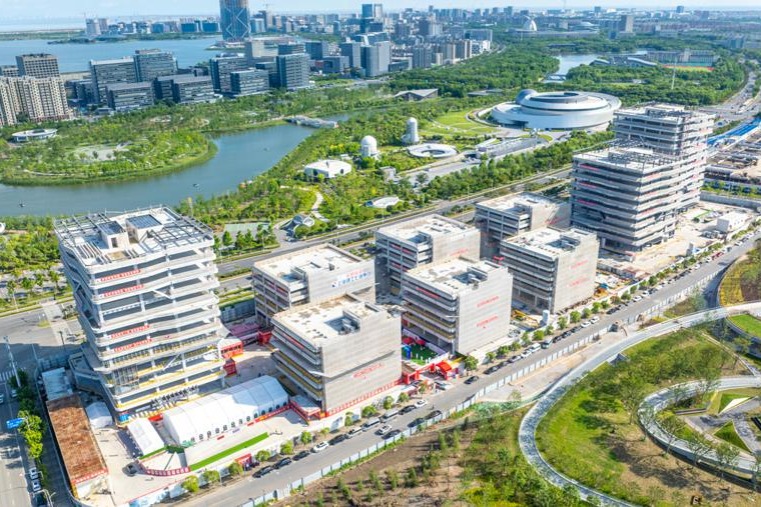Banking on amity


As we celebrate the 10th anniversary of China's principle of amity, sincerity, mutual benefit and inclusiveness in neighborhood diplomacy, the glue binding China-ASEAN relations must be nurtured to unleash game-changing deeds
Editor's note: The world has undergone many changes and shocks in recent years. Enhanced dialogue between scholars from China and overseas is needed to build mutual understanding on many problems the world faces. For this purpose, the China Watch Institute of China Daily and the National Institute for Global Strategy, Chinese Academy of Social Sciences, jointly present this special column: The Global Strategy Dialogue, in which experts from China and abroad will offer insightful views, analysis and fresh perspectives on long-term strategic issues of global importance.
Ten years on, China's neighborhood diplomacy has become a model of partnership featuring amity, sincerity, mutual benefit and inclusiveness.
As 2023 is drawing to a close, China's renewed interest in amity vis-a-vis its neighbors in the Association of Southeast Asian Nations makes the 10th anniversary more commemorative and meaningful, even more because it coincides with the 20th anniversary of China's accession to the Treaty of Amity and Cooperation in Southeast Asia.
The TAC, which is the foundational peace treaty for ASEAN, was established in 1976. It embodies the universal principles of peaceful coexistence and friendly cooperation among its member states and beyond. In retrospect, China was among the first countries outside ASEAN to accede to the treaty in 2003, followed by the rollout of China's principle of amity, sincerity, mutual benefit and inclusiveness in neighborhood diplomacy 10 years later.
It shows consistency on the part of China in upholding its commitment to promoting perpetual peace and cooperation in its global engagement over the decades. This has later evolved into three global initiatives — the Global Development Initiative, Global Security Initiative and the Global Civilization Initiative — that embrace the entire humanity. Within two decades after China's accession to the treaty, the emergence of the three global initiatives has taken the shared aspirations of the TAC to a higher plane.
Complementarity of the three initiatives in the pursuit of enduring peace and prosperity through cooperation in development has proven a viable alternative to the prevailing international order which is characterized by an ailing global governance.
From the Chinese perspective, development and security can never be mutually exclusive. Development is seen as the basis for security, while security sets the conducive environment for development. Indeed, there can be no sustainable development without peace and no peace without sustainable development.
While acknowledging that development needs are universal, solitary development with uneven level of development across any region is no guarantee to collective security. Conversely, it's the wisdom of amity which encapsulates the willingness to share the development dividends that will deliver peace.
The lofty ideal of building a global community with a shared future epitomizes the wisdom of sharing — be it in the wealth of expertise, experience or fruits of prosperity — from the perspective of Chinese philosophy. This goes far beyond the notion of "prosper-thy-neighbors" as the BRI is a global endeavor. It goes beyond the close neighbors of China.
In this context, the Global Development Initiative serves as an enabling development architecture that promotes transborder cooperation in sustainable development, aligning it to the 2030 United Nations Sustainable Development Agenda. Alongside the BRI, the Global Development Initiative starkly contrasts the working principles of both the Global Gateway initiated by the European Union and the Partnership for Global Infrastructure and Investment (PGII) sponsored by the G7. Both are largely motivated by the private investment returns.
Undeniably, the amity has remarkably transformed the regional landscape of infrastructure and logistical connectivity in ASEAN. The China-Laos Railway and the Jakarta-Bandung High-Speed Railway could not have been possible, had the projects not been motivated by the sustainable amity underpinning the BRI.
This crucial element in the neighborhood diplomacy of China is now all set to scale greater heights and explore more dimensions of the ASEAN's development needs, following the announcement of eight major steps at the third Belt and Road Forum for International Cooperation.
As we usher in the second decade of the BRI, more green initiatives centered on low carbon sustainable development are now the new priorities on the ASEAN development agenda, ushering in a new age of development for the well-being of its 670 million people.
Unlike the "hard connectivity" involving physical infrastructure that warrants heavy capital outlay, the eight major steps promised capacity building and skill empowerment to meet the societal needs of the BRI partner countries, thus adding a new dimension of "soft connectivity" to the mammoth initiative.
Parallel to this, the "small yet smart "programs related to livelihood assistance are anticipated to emerge in numbers to benefit millions of people across the Global South, including ASEAN.
The programs might sound small and micro in size as compared to the gigantic development projects in the past. Nonetheless, this is an important move looking set to help reshape the competitiveness of the BRI partner countries. All these could not have been possible had it not been for the consistency and persistency in upholding the amity, and the creativity to translate it into game-changing deeds.
In hindsight, the initial shared aspiration of pursuing amity between China and ASEAN could have been merely motivated by the contemporary needs for promoting peace and prosperity across the region. Little had the TAC's founders and signatories envisioned that this has gone a long way in unleashing enormous potential of multidimensional development in the region of over 2 billion people.
Be that as it may, we can ill-afford to take the established amity for granted. While we celebrate the 10th anniversary of China's neighborhood diplomacy alongside the first decade milestone of the BRI, the element of amity which remains central to the China-ASEAN relations must be properly nurtured with care and sensitivity, more so against the backdrop of widening global trust deficit amid the prevailing international order.
The author is president of the Belt and Road Initiative Caucus for the Asia-Pacific and former transport minister of Malaysia. The author contributed this article to China Watch, a think tank powered by China Daily. The views do not necessarily reflect those of China Daily.
Contact the editor at editor@chinawatch.cn.


































